
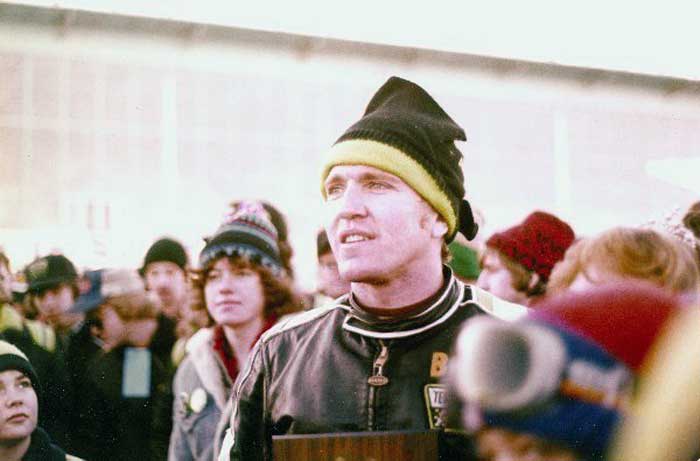
Team Arctic has been home to many of the all-time greatest snowmobile racers. Names like Tucker Hibbert, Blair Morgan, Kirk Hibbert, Brad Pake, Larry Coltom, Roger Janssen and others are engraved on the most prestigious trophies and etched in the imaginations and memories of fans around the world.
Among that elite list of all-time greats is a humble man from New London, Wis., named Bob Elsner.
For a fan of Team Arctic’s Sno Pro era from 1974-1981, Elsner needs no introduction. He first made a name for himself as an independent racer in the early ‘70s. His status grew when he became a member of the mighty Factory Team Arctic oval team midway through the 1975 season. Wins at nearly every track in North America solidified his position as one of oval racing’s top drivers.
When he won the Eagle River World Championships 1979, Bob Elsner became a genuine legend and hero to thousands of race fans.
That legend would grow in subsequent seasons, until his retirement in 1981 when Arctic Enterprises went out of business.
In the nearly quarter-century since he hung up his leathers, Bob Elsner has maintained a low profile. To the point that many thought he’d disappeared altogether.
Elsner hadn’t disappeared. He just stepped back which, coupled with a quiet, humble demeanor, meant that was out of view to the legion of fans and competitors who’d hoped to one day meet him.
That chance happened for me recently when a small group of Team Arctic racers and personnel reunited for the first time since 1981. While shooting pictures of that reunion, I asked my first true snowmobile racing hero if I could interview him for this site. Thanks to the gentle nudging from his former teammate Jim Dimmerman, Elsner agreed.
And for that I will be forever grateful.
AI: Fair warning to you Bob: I have a lot of questions. I’d like to start with the where you’re at in life today, in terms of where you’re living, age, family, hobbies and work?
Elsner: Well, I’m 71-years old and live in New London, Wis., with Alice, my wonderful wife of 43 years. We have two children and four grandkids. My son and his family live in New London, while my daughter and her family live 18 miles away, in Menasha, Wis.
I’m retired now, so I have some free time. I golf one day a week with friends, and I’m trying to finish restoring a 1970 Mach 1 Mustang car that I’ve had for 15 years, to go along with the 1965 Lincoln that I restored a few years ago. I still have chores though, like cutting and splitting wood, and mowing. We live on 60 acres of family land, so there are always projects to keep me busy.
AI: When we talked the other day, you mentioned that you still snowmobile about 1,000 miles a year, which I think is really cool. Tell me about the riding you do?
Elsner: I bought my first sled in 1969 and I’ve ridden ridden snowmobiles ever since. I suppose there were some years when I was racing that I didn’t ride too much, but we always owned sleds, even during those years. And early in my career, when I raced as independent, I would trail ride the same sleds that I raced on the weekends. I especially remember my 1971 Rupp Magnum, winning a fair amount of money by racing it on the weekends, but riding it on the trails during the week.
These days I ride a 2004 Arctic Cat T660 Turbo. Before that I rode a 2001 Z 440 Sno Pro, the fan-cooled model, which I still own. But I mainly ride the Turbo. I love how quiet it is, and its power. Plus it gets great gas mileage, sometimes around 20 mpg.
AI: What kind of riding do you prefer?
Elsner: I like to go trail riding with friends and family. We mostly ride during the week, leaving from here in New London. The riding here is a mix of woods and farmland, which I like. I used to go closer to 1,800 miles a season, but I’m slowing down a little. Plus, I’m one of the trail groomers for our local snowmobile club.
AI: Really, that’s awesome? Tell me about that.
Elsner: It’s the Northport Snoriders club, which I’ve been a member of since I quit racing in 1981. I’m one of three groomers on our section of trail, which we groom twice per week using two tractors and two drags. It takes about 8.5 hours to groom the entire section.
The club used to have a lot of fundraisers, put on grass drag race and an oval/lemans race. That stuff is a lot of work though, and we’ve moved away from doing some of those events. There’s a lot of work involved for clubs, and a lot of money to make the trails happen.
AI: I think it’s great that you do that… thank you! Now I want to shift gears and talk about racing. Have you continued to follow snowmobile racing since you retired from competition?
Elsner: Yeah, I’ve continued to follow it. I’ve always been curious about it. I follow Tucker Hibbert: He’s quite the racer! I watch the X Games, which is very entertaining. But it also looks pretty dangerous.
Now snocross is the most prominent form. Of course it used to be ovals, but that’s kind of died out. We still have some great races up here in Northern Wisconsin, but it’s a handful of events, and they don’t get much coverage from the media up here. I like to know who won at Eagle River each year. I followed P.J. Wanderscheid when he was winning all those years.
AI: The other day you told me that you spectated at Eagle River for a lot of years.
Elsner: That’s right. Ever since I retired from racing, a group of 6-8 of us would snowmobile from New London to Eagle River during Derby weekend. We’d spend 3-4 days up there, riding the trails, but then watching the races during the weekend. And after the World Championship final, we’d ride home. It was quite a haul, usually a 4-5 hour ride home. But we took a break from that tradition a few years ago, probably around 2010. The thing is, the way they run those races at Eagle…there are too many breaks in the action. It got kind of boring, so we quit going. Plus, they need to get back to Stock class racing. That’s what I like to see, what the stock sleds are capable of.
AI: You and me both! What kind of similarities and differences do you see between the Champ 440 race sleds of today compared to the Sno Pro race sleds you competed on?
Elsner: Well, from the last sled that I raced, which was a 1981 Arctic Cat Sno Pro, I still see a lot of similarities. The steering looks the same. The overall proportions are similar. I know they have more horsepower now, and they’re certainly more refined.
I think if the factories had kept racing that the sleds would be a lot different. Maybe it would have meant twin trackers from all brands?
Again, I like stock class racing on stock sleds. I think the sport would be better served if the factories spent more time racing cross-country.
This film of the 1979 World Championship is, in my opinion, THE greatest movie ever made about snowmobile racing.
AI: Probably like a lot of race fans, the event that I associate with you is the 1979 Eagle River World Championship, which is a seminal event in Arctic Cat racing history. When you look back on that victory now, what do you think about…what plays through your mind?
Elsner: I think about what could have been. (Long pause) That was a weekend in which Bucky [the nickname that Elsner and other Team Arctic personnel used when referring to Jim Dimmerman, his teammate]… (Pause)… he won three finals in a row. He looked like he’d be the guy to win the WC. I thought, here we go; Bucky is going to clean house this weekend.
Then it’s time for the WC final, and there’s the bad start [Editor’s note: Elsner is referring to what is generally regarded as a jumped-start, but that wasn’t restarted.]. So, what do you do, go or hope for a red flag?
I went for it, not being sure if we’d get the flag or not. I think I was in third or fourth, and when we came around turn four on the first lap, the flag was green. So we’re racing.
Lo and behold, I came out on top and won the race. And of course I was really happy. I was 36 years old at the time and, truthfully, I wasn’t sure how many more of those races were in my future. We celebrated that night, and it felt great to win after trying for so many years.
When I look back now, I think about that, but I also think about Jim. He had a real good chance for the sweep, and he still finished third after the terrible start.
AI: Was winning the World Championship a life-changing event?
Elsner: There aren’t too many people who win the WC, and up to that point in 1981 there were a lot of great racers who tried and never won. Guys who should have won. Guys like Davey (Thompson) and Larry (Coltom) and lots of others. So yes, it was a life-changing event.
AI: I’m eternally grateful for that short film that Arctic Cat made of the ’79 World Championship, for a lot of reasons. The footage of you and Dimmerman makes it look like you and your machines could corner exactly where you wanted. There are a couple segments [check out 2:42] where you’re so close to other racers that that you nearly touch. Were those sleds as wonderful to drive as they look on the film?
Elsner: When you’re racing like that, if something’s not right with sled, you’re not going to win. When the sled is right, you can do anything with it. That’s what it was like in 79. The sled handled perfect. I could go inside, through the bumps, or outside…anywhere I pointed it. It was one of those weekends when everything worked.
I won WC and Jim won the other three classes. Our machines were as good as they could be.
AI: It’s a rare race where everything comes together and you’re on a different level than the competition, especially when it’s at the biggest event of the year. Had you ever been in such a position to win Eagle River at any other point in your career?
Elsner: The year that (Factory Arctic Cat racer) Davey Thompson got hurt at Eagle – it was 1975 I believe: I was still an independent racer. I hadn’t qualified for the WC that year and, in fact, I’d been disqualified in tech for something… a kill switch that wasn’t working or something like that.
After Davey got hurt early in the weekend, the Factory guys approached me and asked if I wanted to run Davey’s sleds, which of course I did. When I got on that thing…I’ll tell you what: It handled so well! It would run out of clutching about 50 feet before the corners, it was perfect. I knew it could win the WC, but I wasn’t allowed to continue in the WC class because of the kill switch DQ. However, I did win the Mod IV final with that sled.
That was the one other time in my career at Eagle where I felt like I could have won the WC if things had worked out differently. But the truth is, that should have been Davey’s year to win it. And that’s a real example of how luck plays such a big part in racing, and how there were guys who should have won but, for one reason or another, never did.
AI: What were your other best finishes at Eagle River, as well as some of your other career highlights?
Elsner: In 1981 I finished second to that little weasel of Brad Hulings (laughter). I’m joking about Brad. He was no weasel. Just the opposite actually, he was good, he was a small and light guy. He was a heck of a racer and tuner. And a really hard-working kid, both he and his mechanic Mouse [David] Karpik. Those guys had good ideas and worked hard to win. They were great at clutching, and were always testing for holeshots on the Arctic Cat track.
That year [1981] he had the same sled as mine, but with Scorpion fiberglass. I don’t remember much about that race, whether we battled or not.
AI: How does winning the World Championships compare with winning Sno Pro High Point titles?
Elsner: Winning those High Point titles was great and I was proud to wear the Number 1. As a racer that’s a pretty big deal. But in a way it doesn’t compare to winning the WC. The WC is what everyone remembers, it’s the one accomplishment that everyone raced to achieve.
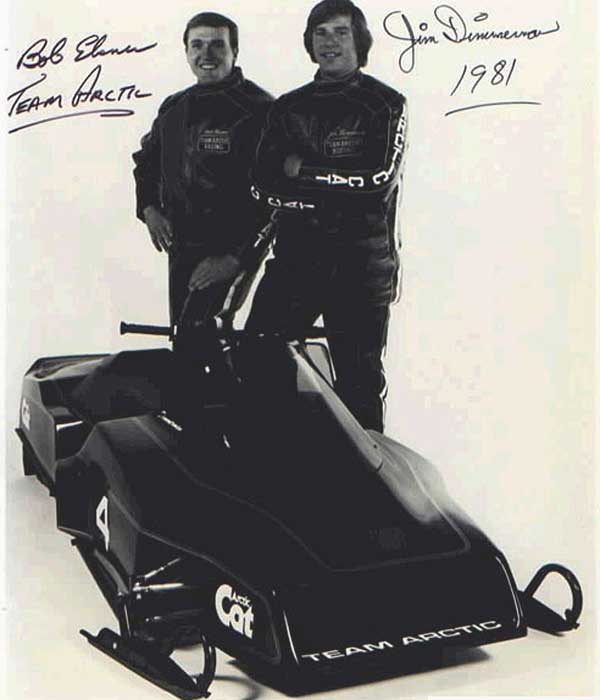
Elsner and Dimmerman pose with the 1981 Arctic Cat Sno Pro, the last machine of its era.
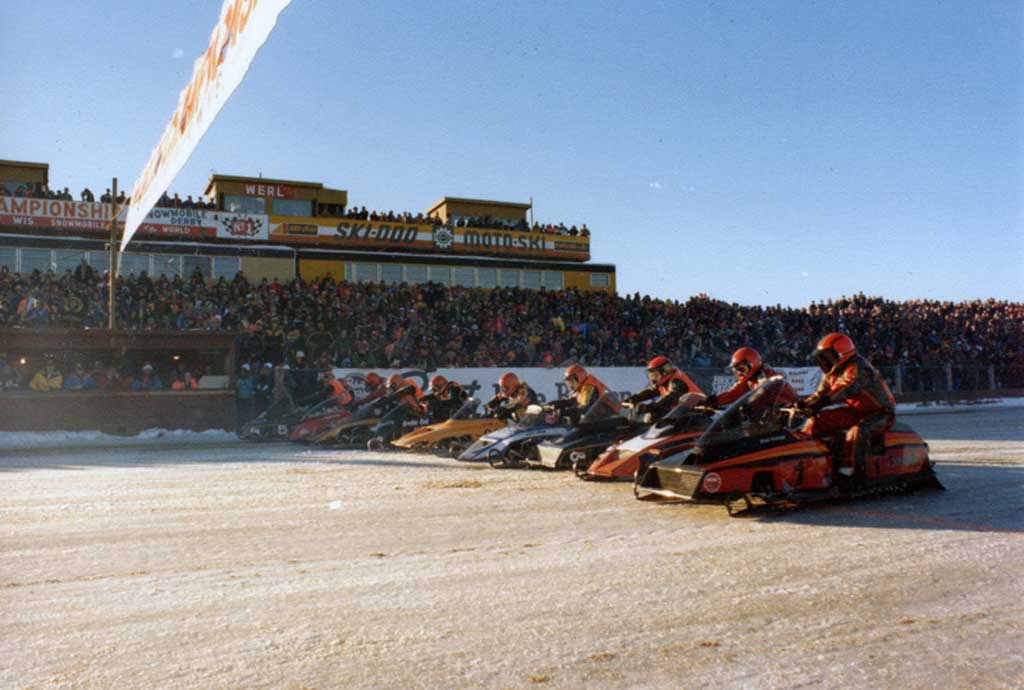
The 1981 Eagle River World Championship was Elsner’s last as a driver. He finished second to (sort-of) teammate Brad Hulings, who raced a Scorpion-branded Arctic Cat.
AI: 1981 was your last season of racing. Were you ready to retire then, or did Arctic Enterprises closing push your decision?
Elsner: I probably would have kept racing another year or two if Arctic Enterprises had stayed in business. I certainly wasn’t ready to quit after 1981. But I don’t really know how many more years I had in me. I was 40 years old at the time, which was pretty old for being a professional snowmobile racer.
AI: Were you at all tempted to race as an independent again?
Elsner: You know, I looked into the price of a Ski-Doo twin tracker. They were a lot of money. And I would have had to buy all the equipment, a truck and trailer…everything. Plus I was a really an Arctic Cat guy. I couldn’t have jumped from one brand to another. I’d been racing for more than a decade at that point. During the Team Arctic years that meant living in Thief River Falls, away from my family.
So really, I didn’t have to think much about continuing racing. When 1981 was finished, it was time to call it a day. The timing was pretty good.
AI: What did you do for employment after you quit racing?
Elsner: I worked in construction, in the blacktopping business and, later, for a concrete company. I did that even when I was racing, because the timing worked out that I would get laid-off just before the start of the race season. Even as an independent, was in operating engineers doing construction. Blacktop business. Did that even when I was on Cat. Operating engineer.
AI: Did you keep any memorabilia from your racing career?
Elsner: Well, my wife Alice kept a lot of the stuff in a box for me. And truthfully, I’d never looked in the box until last week, to prepare myself for some of the questions you wanted to ask. She kept a lot of stuff! Eagle River programs, promotional photography, newspaper and magazine articles. A lot of stuff!
I also kept all the trophies I’ve won. They’re in the basement, under a tarp. And I still have one or two sets of the leather racing gear, plus some helmets.
Oh, I also have the 1979 Jeep that I received for winning the WC that year. That Jeep wasn’t the best vehicle…it got rusty pretty quickly. It’s funny, but I bought a new 1978 Ford pickup for Alice, so she had a good winter vehicle while I was living in Thief. And lo and behold, a few months later I won the WC and got the Jeep. Well, I kept both vehicles to this day. The Ford is still in great shape, but the Jeep is a rusted mess. I need to get rid of it.
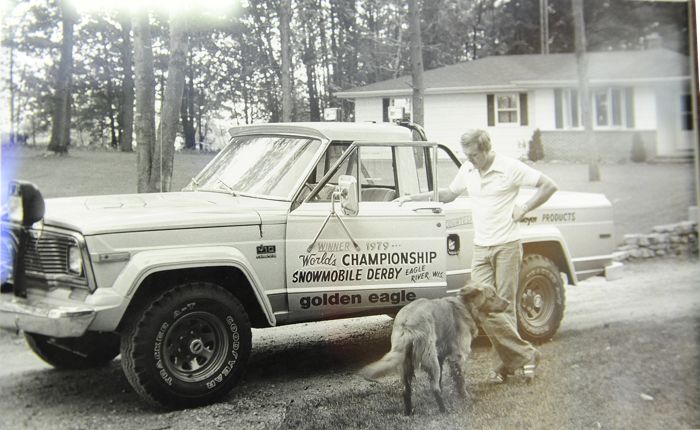
AI: (Laughter), does the Jeep still look the same as it did when you won it?
Elsner: Not long after I won it, I removed the lettering on the door. I didn’t want all that stuff on my truck for driving around New London. I kept the Meyer lettering on the side of the bed though.
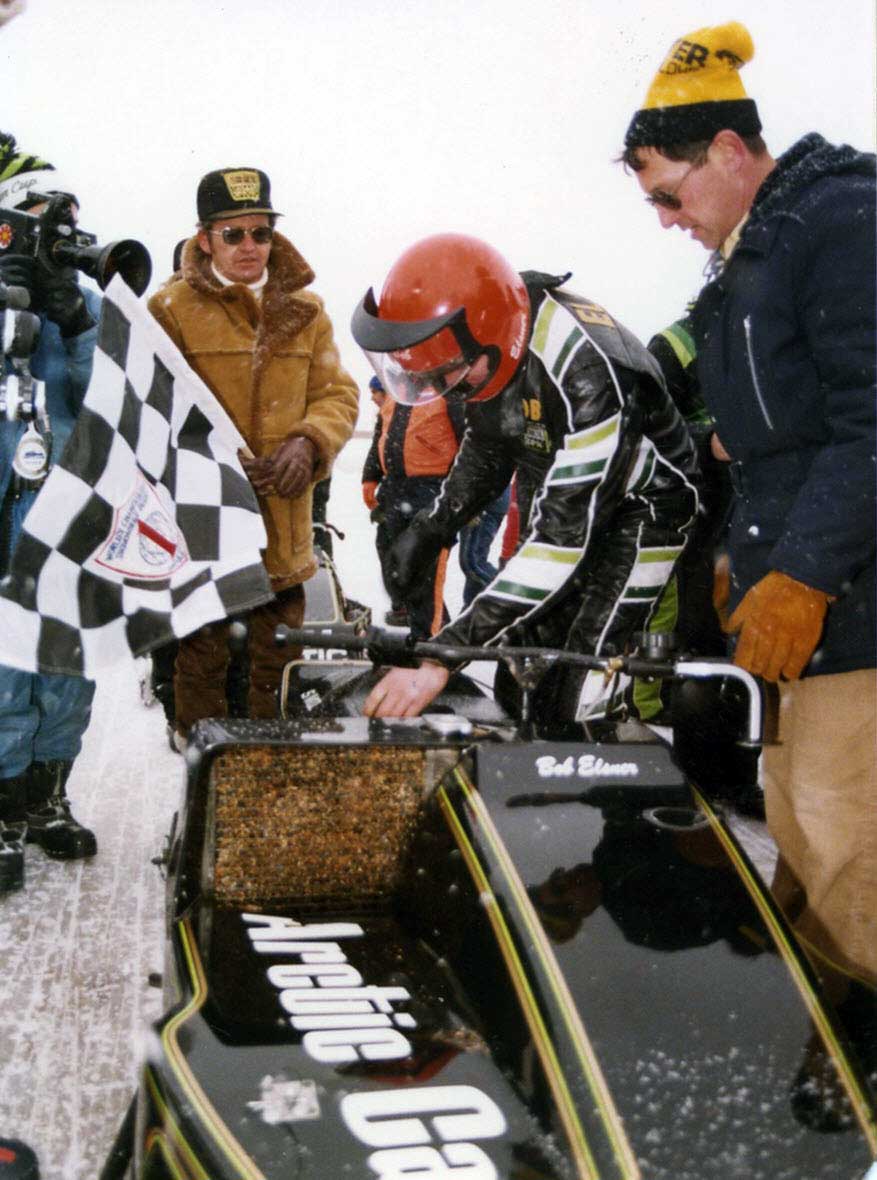
AI: Maybe you can settle one of the all-time great mysteries that has confounded Arctic Cat collectors for years: Do you know where your 1979 Eagle River Championship sled is?
Elsner: I really don’t know what happened to that sled! I’m sure I kept racing it for the remainder of the ’79 season. At the end of the season, it wasn’t offered to me. But there wasn’t much of that kind of collecting back then.
I know there was a fire in the Arctic Cat Engineering building back then. The sled could have been involved in that. It could have gone to Salvage and been bought by a dealer.
For 1980 we built all-new sleds, like we did every year. I never asked what happened to my ’79.
AI: There’s another long-debated question: Was there ever an A-frame front suspension Sno Pro sled that you saw or tested during the final year of Arctic Enterprises?
Elsner: If there was one, I never saw it. We worked around Engineering, so we saw a lot of projects, but I never saw an A-frame Sno Pro sled. The first year I saw an A-frame front suspension was when Cat built the AFS consumer sled for ’84-85.
AI: What was your all-time favorite race sled?
Elsner: Well, it depends. Of course you win the WC, so that’s you’re all time favorite.
But when I was independent racer in 1973, I had [‘73] Arctic Cat 650 EXT. It was really light and fast. I won a lot of races and money with that sled. So that’s also a favorite.
AI: Was there a particular racer who you really enjoyed competing against?
Elsner: When you go to the races…the weekend starts and you’re standing in the pits and watching everyone. The guy you want to beat is the guy who looks the fastest that weekend. Some days it was Hulings, some days it was Dimmerman, Hayes…on any given day, I wanted to beat these guys. Sometimes I did and some days they beat me. But no, I didn’t have a favorite person to race against. I liked racing most of them.
AI: Was there another racer, mechanic or colleague who was an especially important influence on you and your racing career?
Elsner: I had a lot of people who were important to my racing career. But the one I think of the most is my old buddy, Al Stern.
In 1967, Al was the first guy in our area to buy a Ski-Doo. Then he started racing it, kind of launching interest in racing for our area. After that he rode Arctic Cats for Sonny Borchert [an Arctic Cat dealer in Neenah, Wis.].
Around that same time I had purchased a 1969 Yamaha and also started racing. There was this guy on an old Panther who lapped me in a XC race! It was Al, on an Arctic Cat that was sponsored by Borchert.
That wasn’t going to work, so I went to Borchert to buy a Cat, but he talked me into buying a Rupp to race, which was good because I won a lot with that sled.
The next year, 1972 I think, Al had this four-cylinder Cat: a King Kat. That thing was something, it had so much horsepower that it kept blowing belts (laughter). Al was absolutely sick and tired of it: He had such bad luck. So Al says he’s going to go race Yamaha. And he tells Borchert to hire me.
Well that was pretty good timing for me, because in 1973 Arctic Cat came out with the EXT 650, which was the best sled to race that year. He maybe could have been in my position if he’d have stayed?
To this day, Al never lets me forget that I lucked out in that whole deal! (Laughter) I still golf with Al once a week, so we have plenty of opportunity to laugh about it.
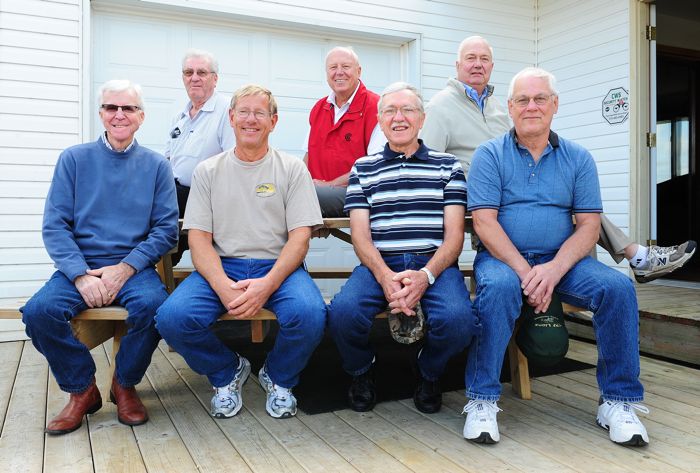
The nucleus of the Team Arctic Sno Pro program gathered recently for a reunion. From L-to-R: Dave Thompson, Roger Skime, Jim Dimmerman, Bill Decker, Bob Elsner, Bill Ness, and Larry Coltom.
AI: There was a small Team Arctic Sno Pro reunion recently, organized by your former Team Manager Bill Decker along with former CEO Bill Ness. It was those guys, along with you, Dimmerman, Larry Coltom, Dave Thompson and Roger Skime. What was that reunion like for you?
Elsner: I really enjoyed it. It was like the family was back together. It was the first time all of us had gathered in one place since 1981. To see all those guys, after all those years, was really good.
I’m comfortable with small-sized events like that, but not big gatherings with a lot of people, like the Arctic Cat 50th or the Eagle River 50th.
AI: I end all my interviews asking for a story about Roger Skime. What’s a Roger Skime story that you can share?
Elsner: I didn’t have a lot to do with Roger when I was racing for Arctic, because Roger was in Engineering rather than the Race Department. But I always saw that he worked his butt off. He would stay working late at night, long passed dark. Always. He’s a wonderful guy.
AI: Bob, thank you so much for agreeing to this interview. I want you to know what an honor it’s been to meet you and talk with you.
Elsner: Well you’re welcome. Thanks for doing it.

Long before he landed his factory ride with Team Arctic, Bob Elsner established himself as a top privateer on the USSA oval circuit.

The lone independent among a pack of factory oval racers, Bob Elsner (lower left) proved his mettle by getting himself into the 1974 Eagle River World Championships.

When Dave Thompson got hurt midway through the 1975 season, Bob Elsner was given a chance to race for the factory. He became an instant star.
He’s shown here the following season with Larry Coltom and Thompson.
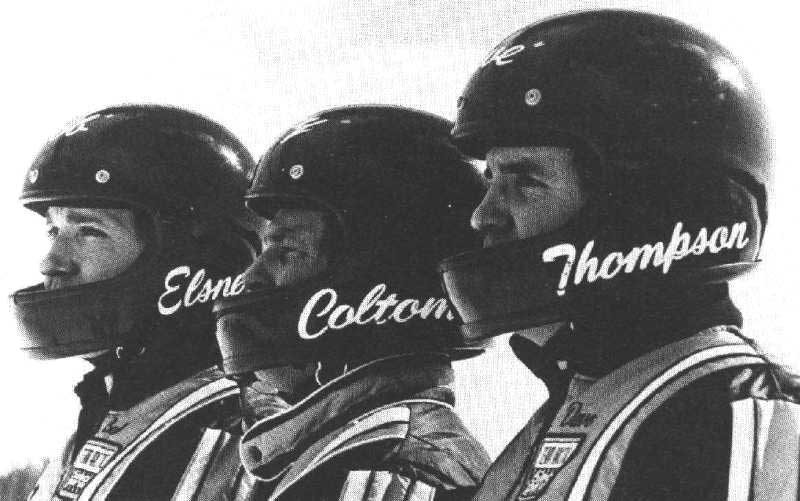
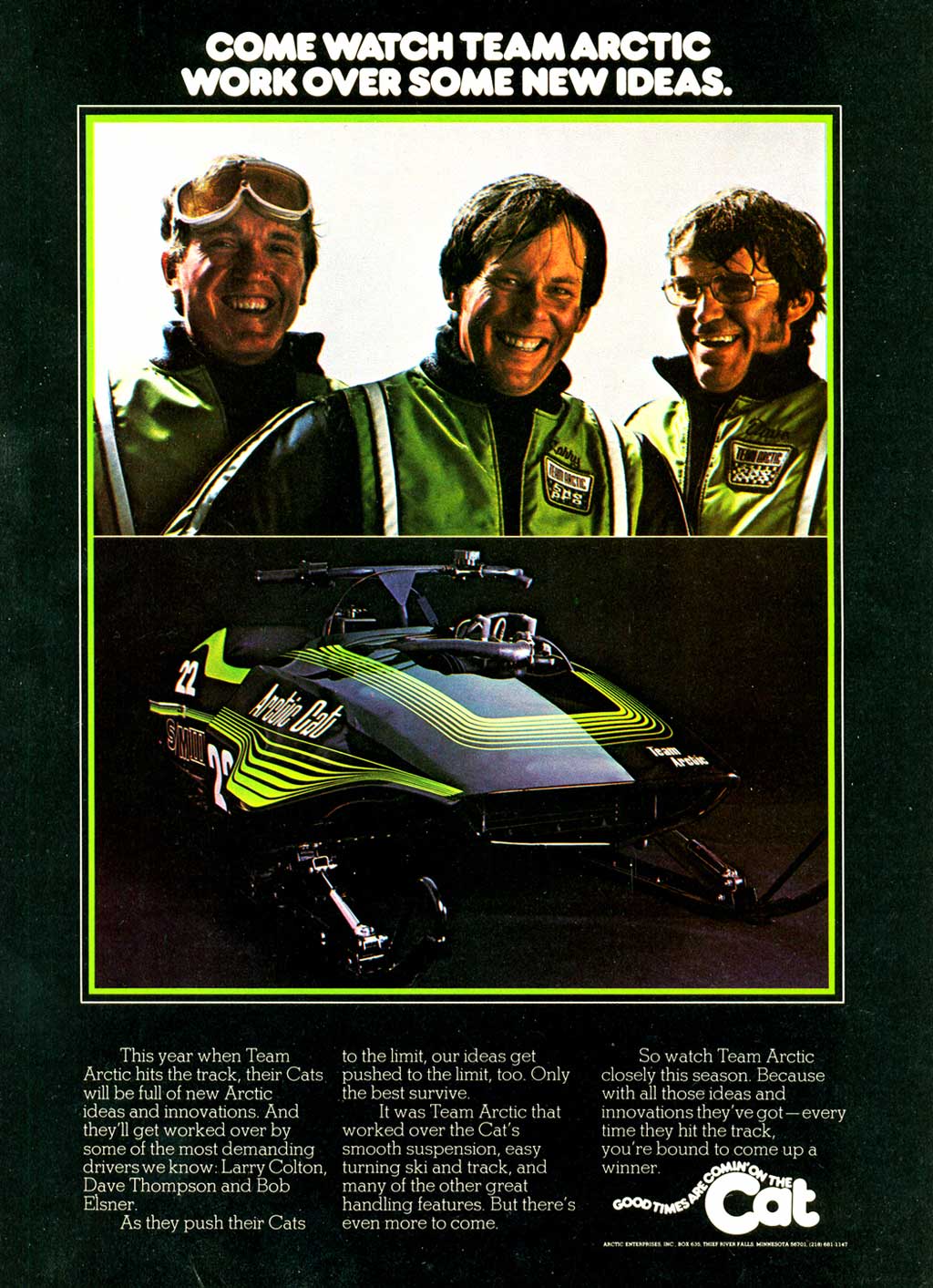
In the 1970s Arctic Cat and other manufacturers turned their top racers into stars, making household names of Elsner, Coltom and Thompson. The ad above was for the 1976 season.
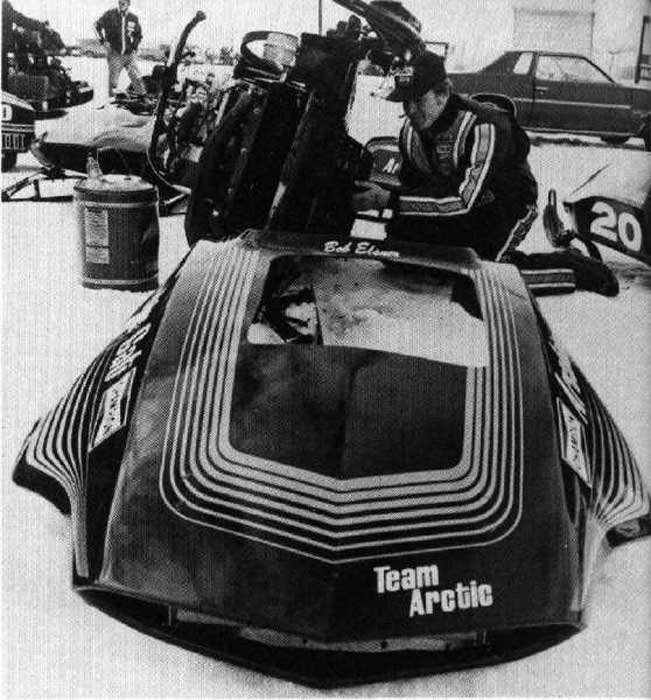
Elsner, wrenching on one of his 1976 Sno Pro sleds.
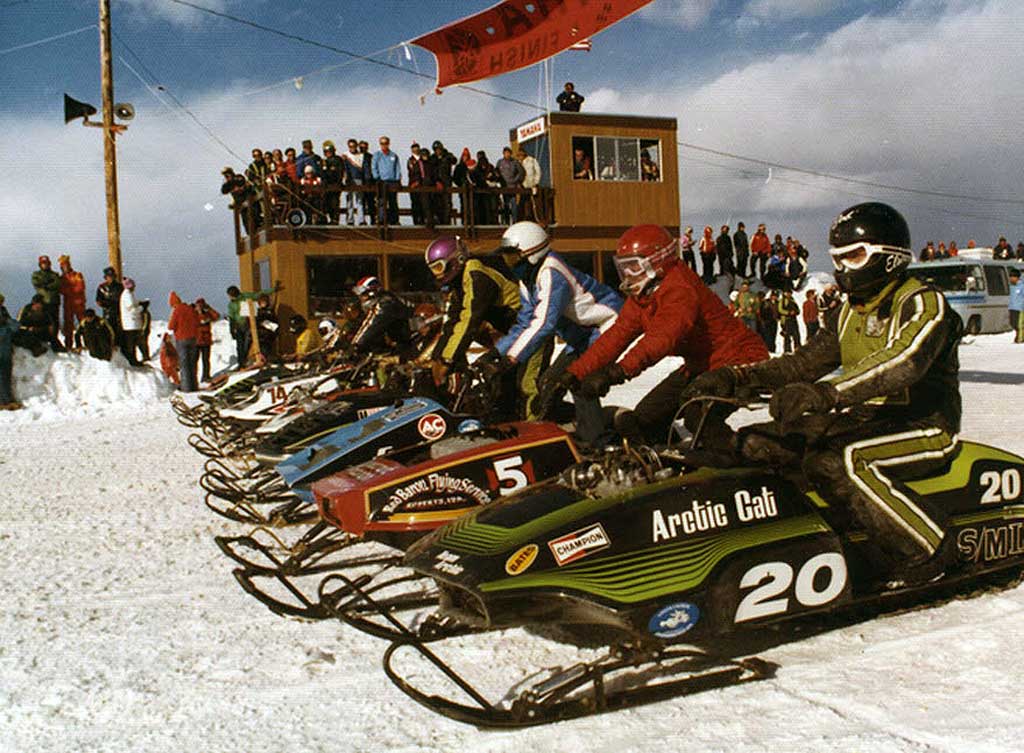
Elsner, racing his ’76 Arctic Cat Sno Pro. It’s amazing how small these sleds actually are, especially compared with today’s machines.

With Dave Thompson’s retirement after 1977, Team Arctic hired newcommer Jim Dimmerman to join Elsner and Coltom.
Coltom would retire shortly into the 1978 season. Elsner and Dimmerman would remain the sole factory drivers through 1981.

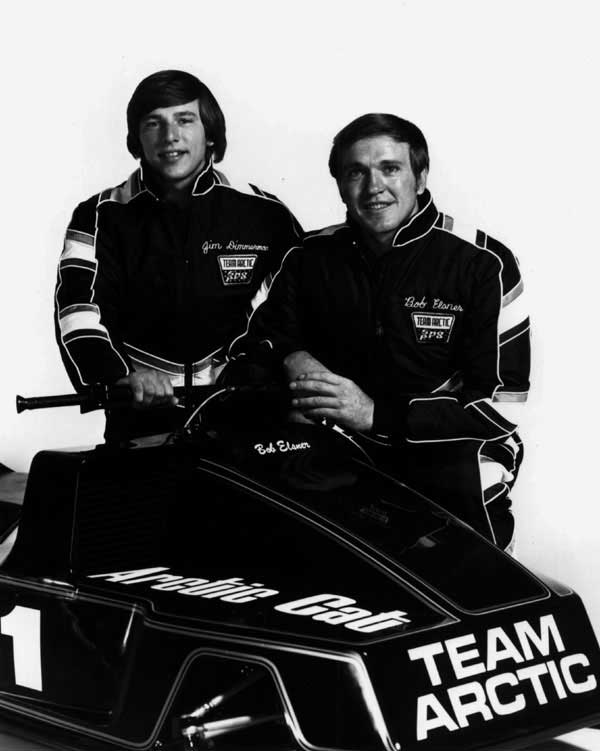
Elsner won the Sno Pro High Point title during the 1978 season, and thus wore the #1 plate for 1979. This was one of the Team Arctic press kit photos for the ’79 season.
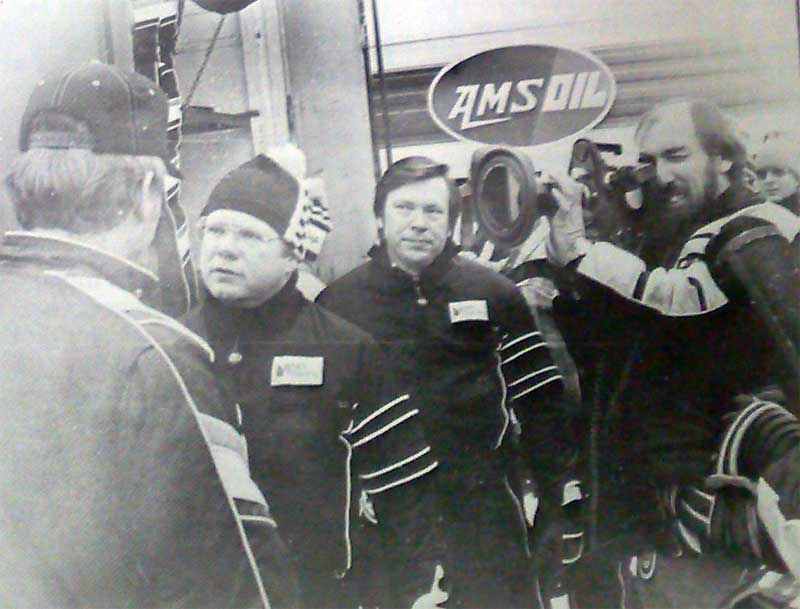
Paul Page interviews Elsner during the 1979 World Championships.

Elsner was a regular on the cover of Snow Week, Race & Rally and USSA’s Sno-Track magazines in the 1970s.
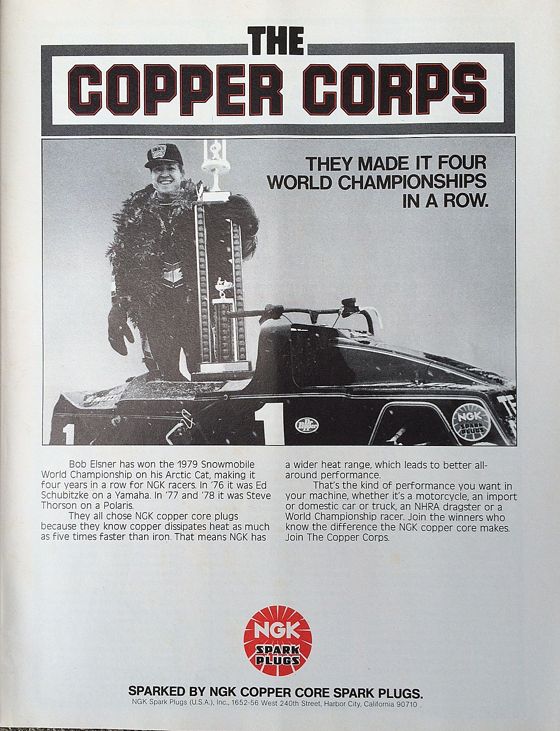
An NGK spark plug ad featuring Elsner’s 1979 World Championships.
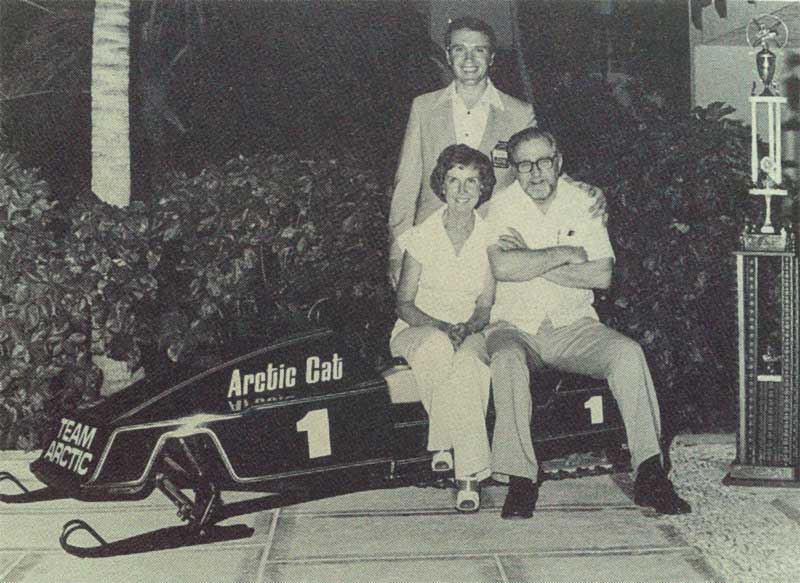
Elsner with Edgar and Hannah Hetteen.
Thanks for reading everyone!




Isn’t the third in from left in the reunion photo Jim Dimmerman?? You have it listed as someone else…. I’m sure he’s gonna be mad missing out on the fame!!
Yep, that’s Jim.
Wow… this interview is going to mean a lot to so many racing fans. The questions and Bob’s answers were so good and so informative – thank you. It’s great to hear he is still involved in the sport. Given his staying out of the public eye for so many years, this may rank as one of — if not the best AI interview yet.
John, that was a great interview. It is very special how you can bring back the great memories of all of those guys who we cheered for on weekends. Going to the races, watching Team Arctic was something my brothers and I looked forward to. It was quite the production from the semi trucks, cool looking sleds, and the way those guys rode and won. I hope they all show up at Waconia so that we can visit with them.
Great work John,one of your best articles yet. Thanks so much for bringing back fond memories and letting us hear from one of the true gentleman of the sport. I remember standing beside him many years ago in the pits at the races in Beausejour, Manitoba. A great thrill for a skinny kid from the sticks.
What a great interview. Thanks Bob and John for sharing! Even as a guy who was born after Arctic went out of business, the name of Bob Elsner has always been nearly mythical… so this was truly enjoyable to read!
John, one of your best stories ever!!! Keep up the great work!!!!!
John,top notch work.Thank you.
when i picture arctic cat oval racing, bob elsner is the image in my mind because he was the king when i started following racing. really great to see him surface here. thanks bob!
Great stuff! Glad to hear Bob is doing well!
Good job John, I’m glad this finally got done. Bob looks great, he was a heck of a racer.
Wow!! Another great story John, thank you, to Mr. Elsner, for sharing with us Arctic Cat fans! I was at the race in Maine where you had so much success! Thank you for those great memories! Oh to have been at that picnic table to be able to talk and listen to these Arctic Cat legends! I for one am a bit envious John! Next interview John needs to be with both Bill’s, Decker and Ness!! Can’t wait
Thank you John for this fabulous interview! Hits Bob’s humble demeanor spot on… His is one of the greats!
Great Job!!
REALLY good stuff John…..thank you Mr. Elsner! If you had any idea how many miles my brother and I went in an oval on our alfalfa field on 68 and 69 panthers trying to be like you guys when we were kids……THANK YOU!
Awesome video, pictures, and story!
Terrific interview!
1979 was the first year that I attended the derby. When you watch that video and see those guys dragging a half barrel, you kind of get the idea of what the atmosphere was like. There were probably about ten people sitting on our trailer riding through town as we left the race! It was quite the experience back then.
Thanks John for the interview. Reading about the Cat Sno Pro’s of the 70’s makes me think back of one weekend when I raced against them. Ah, those were the days!
Thanks for all the nice words everyone, I appreciate it.
Interviewing Bob has been a great experience. He really was my first snowmobile racing hero, so I had some trepidation about talking with him. As it turned out, he’s as gracious and straightforward as they come. Super easy to talk to, zero ego. He’s one of those guys who switches around the conversation by trying to talk about you, rather than himself. I like that.
I love that he started in the sport as a rider, became a racer, then became world champion, then returned to being a rider. And he grooms trails! Full circle.
So my thanks go to Bob. For being a great champion and, more importantly, for being a great person.
Thank you for the wonderful interview & article. It was just last winter where I asked everyone what Bob was doing, hence he wasn’t heard of much after 1981.
Thanks, gentleman.
Kyle
Great interview! As others have stated above, I am delighted that Bob has been enjoying all that life and snowmobiling has to offer since hanging up his race bib so many years ago. If I’m on the trails near New London this winter I’ll be watching for Bob Elsner and offer him a big ol’ black/green thumbs up!
After that January weekend in 79 at Eagle River…..a lot of black and green sleds were sold later. (that very first picture in this article, looks familiar)
Thanks John for another great article!!!
John Sandberg, you absolutely nailed it !
What a great article on a GREAT guy. Absolutely the most respected driver on the circuit. Strong ,Tenacious, I likened him to a junk yard dog on a long chain, don’t turn around, he WILL be there, especially in the closing laps…I learned an awful lot from the ole man. His tenacity certainly inspired me for my WC…. Jim
Great interview! I wish I could have been in this world for this era of snowmobile racing. I still cant believe John Facenda narrated this video. Just shows how great this era of sled racing was. Great article like always John!
Great Job on that interview John. Bob is and was the true humble racer of the day. I knew Bob back in the days of my working at Arctic.
Such a cool look into the past! I love these kinds of interviews.
Yah John, do an interview with Bill Decker and tell him Auggie say’s HI!!
Great interview. As a kid growing up in Eagle River, Bob was my idle.
John, nice interview with Bob, nothing has changed with Bob – same great down to earth guy that I got to know and like when he was racing with us as part of team arctic. I had not seen Bob for a few years, so it was good to be able to visit with him over the weekend. thanks John for great work!!
This is a Great interview! Always went to Eagle River for the races and Bob was fun to watch!! Great that he’s a local boy!! Great job Bob!!
I’ve met Bob Elsner in the past and have a personal autograghed collection of him and his Sno Pro and racing legacy. Mr. Elsner was the greatest Team Arctic racer and simply the best!
BOOM! Like A fine cigar and Bourbon!
What a great interview & long overdue. When Team Arctic came East they never let us down, even when Polaris was doing well elsewhere. These guys were great to be around & Team Arctic was so colorful. Wonderful that Bob is still the low key & personable guy of always. I cherish the time spent with you Bob, & you’re wonderful teammates.
Bruce Bryant